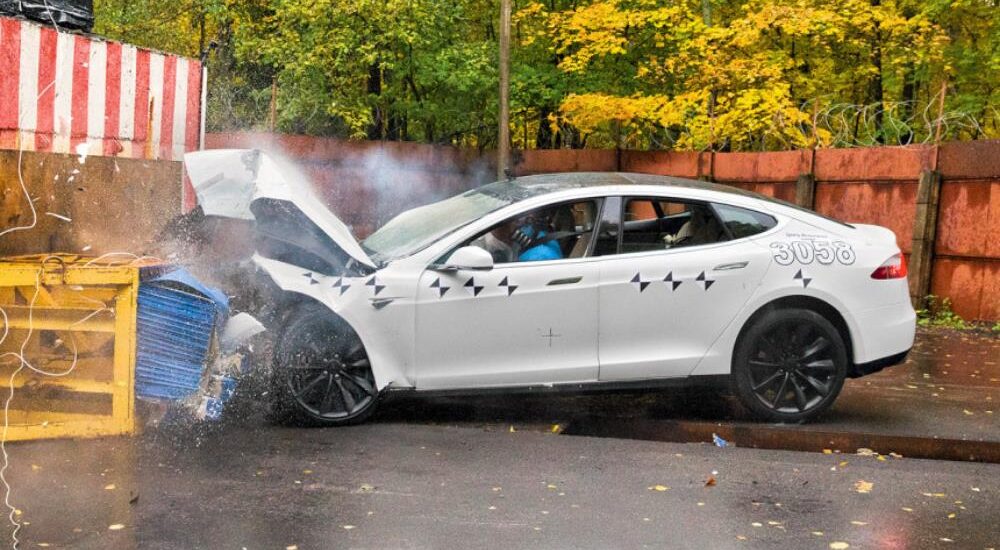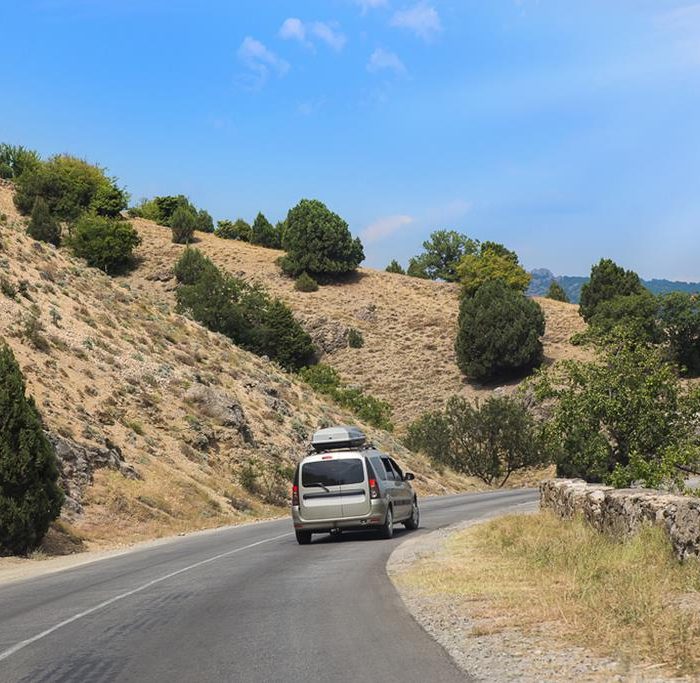Hey, road trippers and gadget gurus! Our friend, the tech blogger Wylsacom (a.k.a Valentin Petukhov), had a distinct intention in mind. They wanted to find out how Apple’s Crash Detection would react when the Tesla Model S crashes. Let’s see how the Tesla fares in the good ol’ ARCAP showdown.
First thing first, Crash Detection is a feature in new Apple smartphones, including the iPhone 14. Apple’s Crash Detection uses its sensors to monitor changes in motion and speed. When the car collides, there is a dramatic change in both. The iPhone 14, mounted on the front panel, had its accelerometer and gyroscope working overtime. They measure the change in velocity and the orientation of the phone. The built-in barometer even monitores atmospheric changes as the car crunches into the obstacle. So its like having ERA-GLONASS, right in your pocket.
Now back to the Tesla. Ours is a 2013 Model S was being evaluated too. Valentin’s crew decided this Tesla would be the perfect chariot for this experiment. And, we couldn’t agree more – given that it had already been in an accident before, the results were eagerly anticipated.
Additionally, this Tesla has an aluminum body – a first for our crash test escapades.
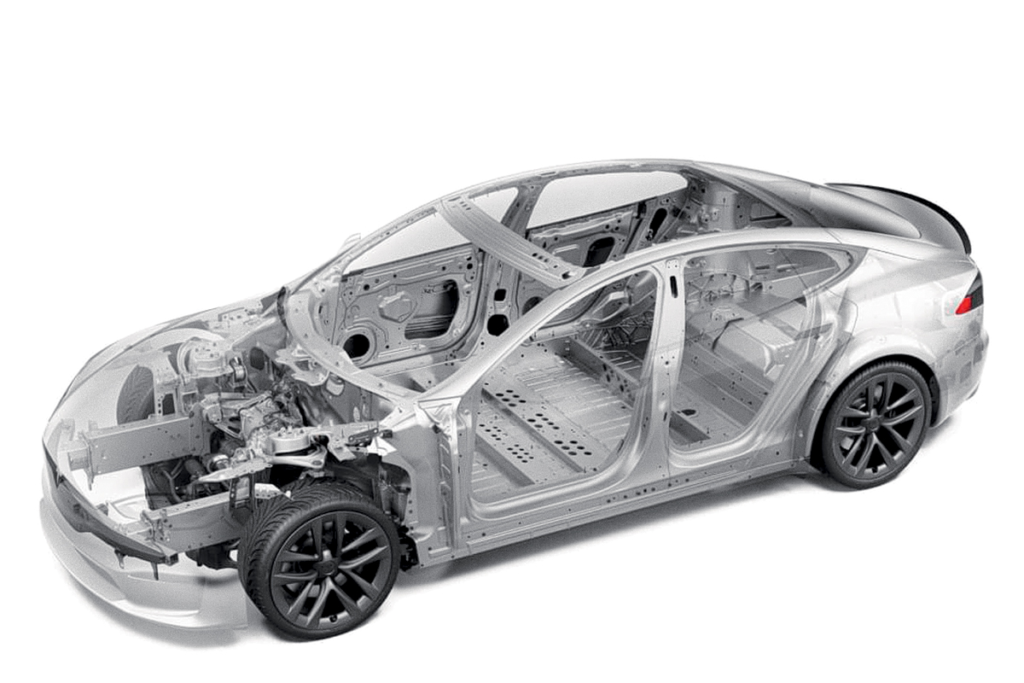
The Tesla Model S electric car is essentially built on an aluminum frame. The detachable part of the front longerons of the all-wheel-drive versions (in the illustration) is shorter than that of the rear-wheel-drive ones.
We’ve been doing these crash tests with used cars since the glorious 90s, so smashing cars to check their safety isn’t new to us. However, this Tesla Model S is unique. A little detective work (checking the VIN number on Copart) revealed that this beauty had been in a pretty nasty head-on collision, probably with a tree or a pillar, at around 23,176 miles (or 37,300 kilometers). The impact was so severe it happened almost smack in the middle, right between the longerons.
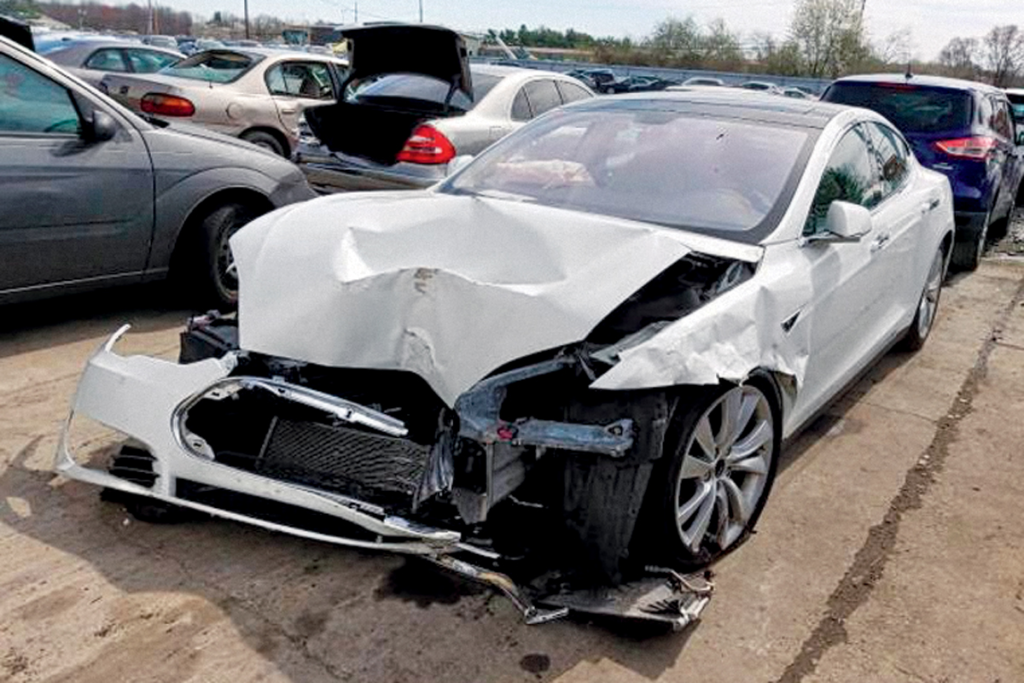
This photo from the American “accident” auction — that’s how our Tesla looked before restoration after the first accident.
Here’s the thing about regular cars – when they have a front-end collision, it’s not just the front that gets messed up. The engine can get wrecked and even cause damage to the rest of the car but Tesla has a trunk on the front. However, side impacts are the Achilles’ heel for the Tesla, especially when it comes to the traction battery under the body. A severe impact can mess up the integrity of the batteries, and, in the worst-case scenario, we could be looking at an impromptu bonfire.
Tesla, led by the visionary Elon Musk, made some upgrades in the later models. They reinforced the bottom and battery with some solid titanium protection. Our Tesla is a pre-2014 Model S, being an older one, didn’t have this titanium suit of armor.
What does this all mean for our crash test? It adds an extra layer of anticipation. We’re not just looking at how well the car holds up, but also what happens to that battery.
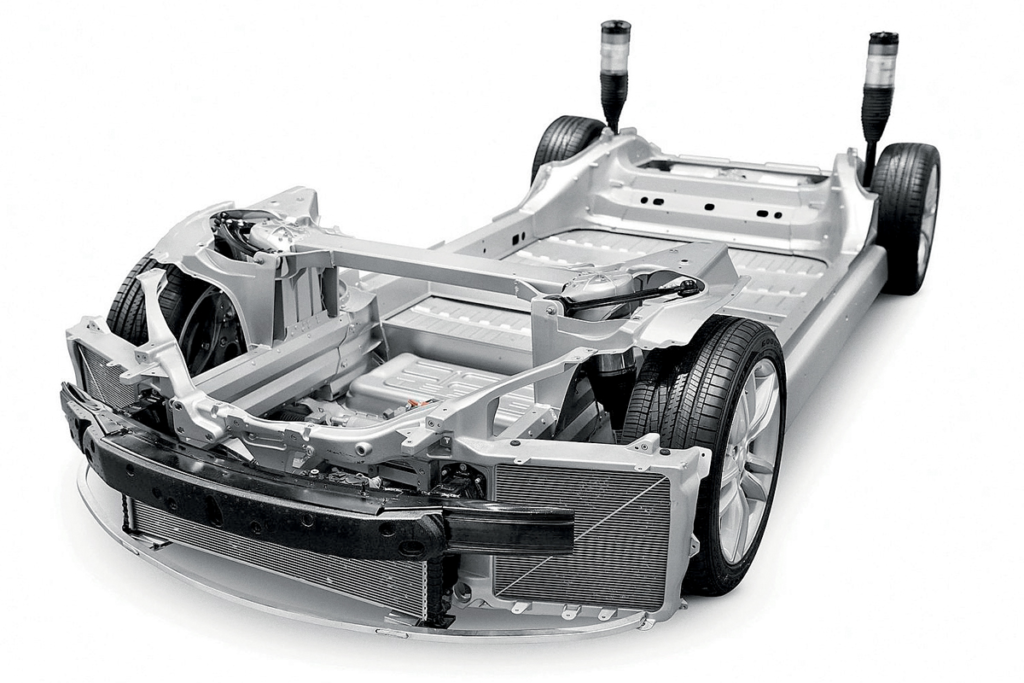
The entire front end is an assembly. In addition to radiators, the air conditioner compressors and air suspension, ABS unit, and steering rack might get damaged in a crash.
From the auction pictures, we can observe that the earlier accident our Tesla endured wasn’t a complete disaster. The front axle’s cross beams and the cabin’s framework remained untouched. The windshield didn’t even get a scratch, but the four front airbags did their job and popped open.
Our Tesla took a trip to Belarus for some repair magic. How did the repairs go? Well, that’s a bit of a mixed bag. The first thing to notice was the colors. Picture a patchwork quilt – that’s the repainted parts. They didn’t exactly match. But, that’s cosmetic, so no biggie.
The more discerning eye might spot different types of fasteners on the aerodynamic coverings under the front compartment. Again, not the end of the world.
The gaps between the headlights, hood, and bumper weren’t even, this might be a bit of a letdown. This is not entirely unusual for a Tesla Model S, especially the early production models. They were known to have some inconsistencies, straight out of the factory.
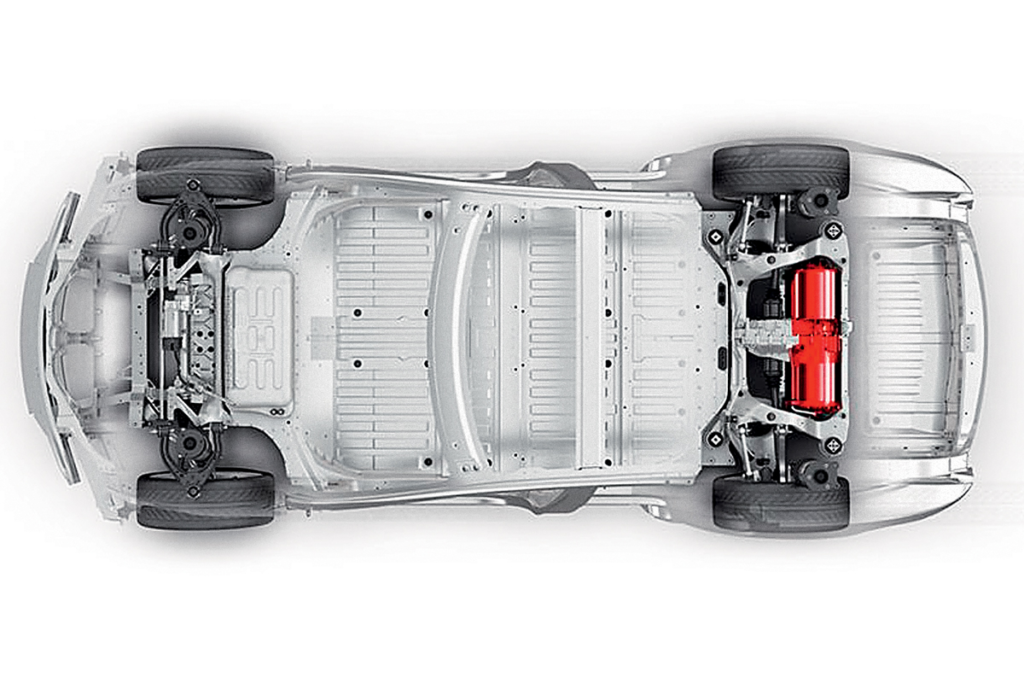
The rear electric motor within the frame rarely gets damaged in crashes.
But here’s the concerning part – the driver’s seat belt pre-tensioner, which had been activated during the prior crash, was not replaced. Pre-tensioner tightens the seatbelt to secure the driver just before the impact and in our Tesla, this crucial component was still in its post-accident state. Also the seat belt’s inertia reel, which is supposed to lock the belt in place, wasn’t behaving either.
We understand that getting new belts and pre-tensioners from Germany or the USA might be like hunting for a needle in a haystack these days. But hey, there’s a world of second-hand parts that could have done the trick. Just to put it into perspective, a functional second-hand pre-tensioner goes for around 10,000 rubles. Compared to the whopping 3,600 euros for four new front airbags, it seems like pocket change.
In a perfect world, after the airbags have embraced you in their cushiony grasp during a crash, the safety system control module (around 800 euros), the front impact sensor (approximately 100 euros), and even the wiring harnesses should be replaced with new ones.

This photo was taken before the crash test: the shortened lower mount of the seat belt indicates the activated pre-tensioner.
When it comes to restoration, it’s no secret that the “Belarusian” way involves using second-hand parts. Those four airbags would set someone back by about 70-80 thousand rubles if they were bought second-hand. The most penny-pinching restorers go a step further and install airbag dummies with resistors just to trick the diagnostic system. In our Tesla we have airbags with markings from a used-parts dealer. Not brand spanking new, but hey, they’re real airbags. The million-dollar question is – will they work?
But let’s not forget about our earlier concern – the seatbelt. If it doesn’t do its job, the ‘driver’s’ head in our crash test is about to making friends with the ceiling near the sun visor. This could cause some serious bending in the neck. Not to mention the risk of damaging the expensive sensor of the Hybrid III dummy.
In order to avoid any unnecessary damages, the test site specialists left the necks of the dummies uninstrumente with sensors.

Neither the iPhone 14 attached to the panel, which flew off from the impact (without damage), nor the iPhone 14 Pro attached to the driver’s seat (in the photo) recognized the crash situation.
But we have two iPhones! One iPhone 14 was attached to the front panel deflector with a regular magnetic holder by Valentin and his colleagues, let’s see where it flies. Another iPhone 14 Pro was securely taped behind the driver’s seat headrest – with the idea that right after the crash it would be possible to look at its display through the open rear window.

So, all batteries are checked, the transmission is in neutral. Acceleration to 64.2 km/h (39.9 mph) with the whirring noise of the catapult – and a sharp impact against the deformable barrier. The Tesla left a good portion of the bumper cladding in it and slightly retreated from the fragments in the smoke from the airbag pyrotechnics.

The front end is crumpled, but the cabin cage has retained its original geometry without any hint of losing the body’s structural integrity.
All four front airbags deployed as they should. However, there’s a concern with the passenger-side airbag. It deployed with such force that it pushed out the windshield in front of it. This was a windshield that had already survived the deployment of the factory airbag. Moreover, the passenger-side airbag didn’t provide the cushioning one would hope for – it flattened, and the right dummy’s head made contact with the front panel.
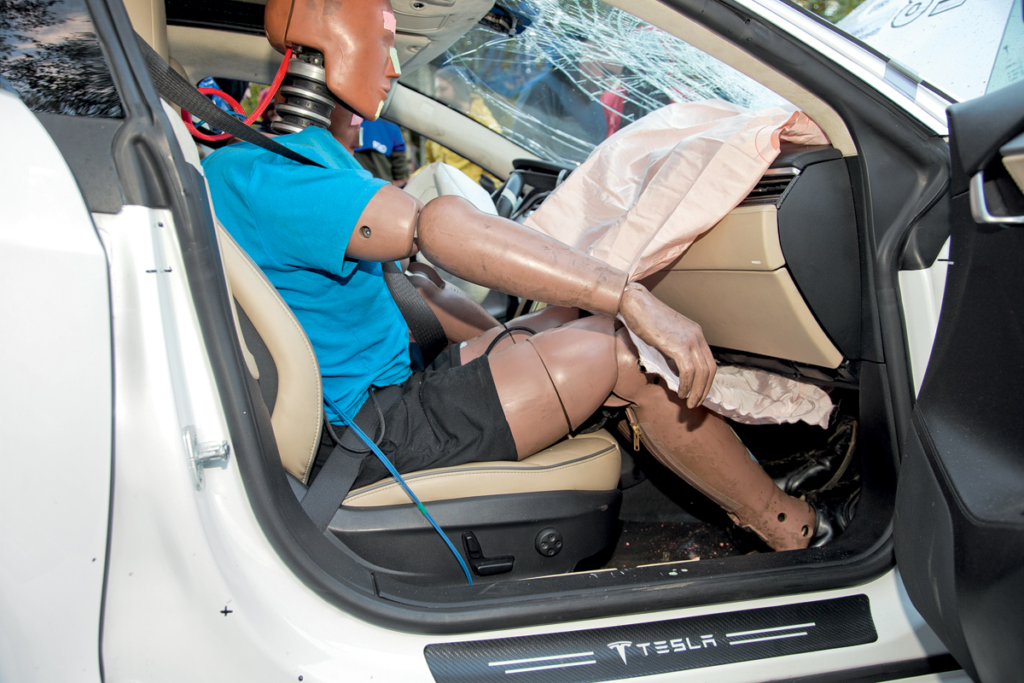
The passenger airbag shattered the windshield in front of it and didn’t protect the dummy’s head from making contact with the front panel.
A little more, and on our infographic. The peak deceleration recorded was a staggering 81.3g, while the average over three milliseconds was 76.5g. To put this in context, anything over 72g is entering a territory where the risk of serious injury escalates, with 88g being the upper limit.
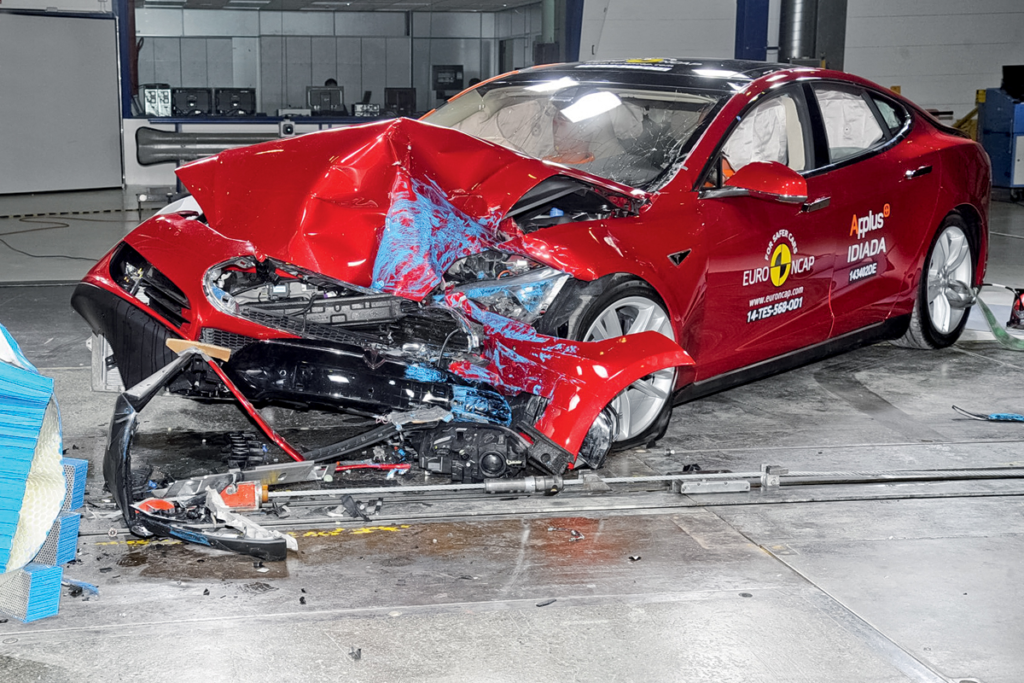

Tesla Model S passed all Euro NCAP crash tests in 2014 with a maximum of five stars (31 points out of 37 possible for the safety of adult passengers). In a frontal impact similar to ours (64 km/h, 40% floors), the cabin remained intact, but due to the breakdown of the passenger airbag, the score for protecting his head was lowered.
Interestingly, this isn’t the first time something like this has been observed. During the Euro NCAP committee’s testing of the Model S in 2014, a similar issue with the passenger airbag was recorded. Although at that time, the readings from the dummy’s sensors didn’t cross into the danger zone, points were still deducted concerning passenger head protection.
Tesla did make adjustments to the software post those observations. This brings us to a crucial question. What version of the software is installed in the Tesla we’re analyzing? And how compatible is it with non-native airbag modules that have been sourced from another car? These are unknowns that add layers of complexity to the analysis.
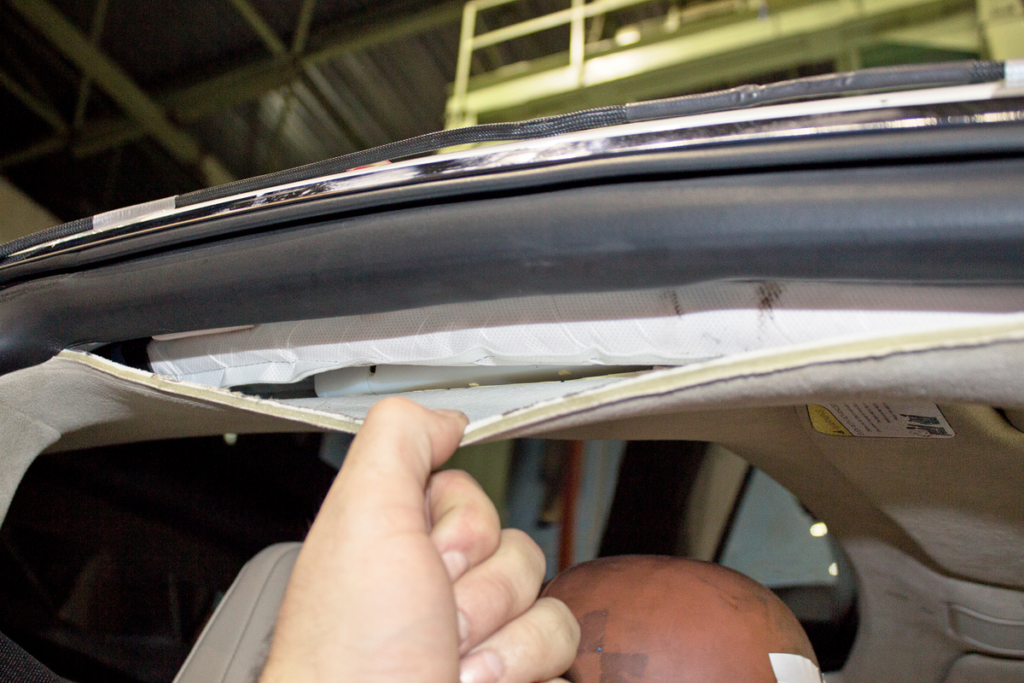
Side curtain airbags did not deploy either after the “American” crash or in our crash test.
It is also strange that the inflatable curtains did not deploy – neither in the first accident in America nor now. Although in similar frontal crash tests by Euro NCAP, IIHS, and NHTSA they did deploy.
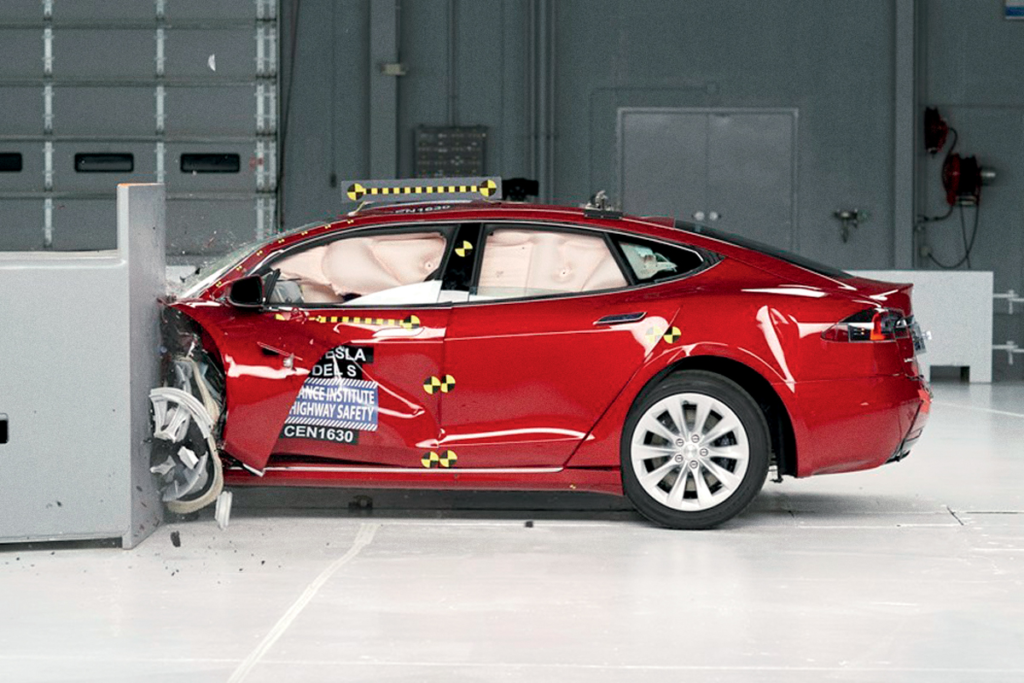
Restyled Tesla Model 5 in 2017 on the frontal crash test of the Insurance Institute for Highway Safety USA (H5) with small. 25% overlap at a speed of 64 km / h: the belt did not hold the “driver”, his head slid off the airbag to the left and hit the steering wheel, and the opened curtain was too short to take the head on. As a result, the rating is only “satisfactory”.
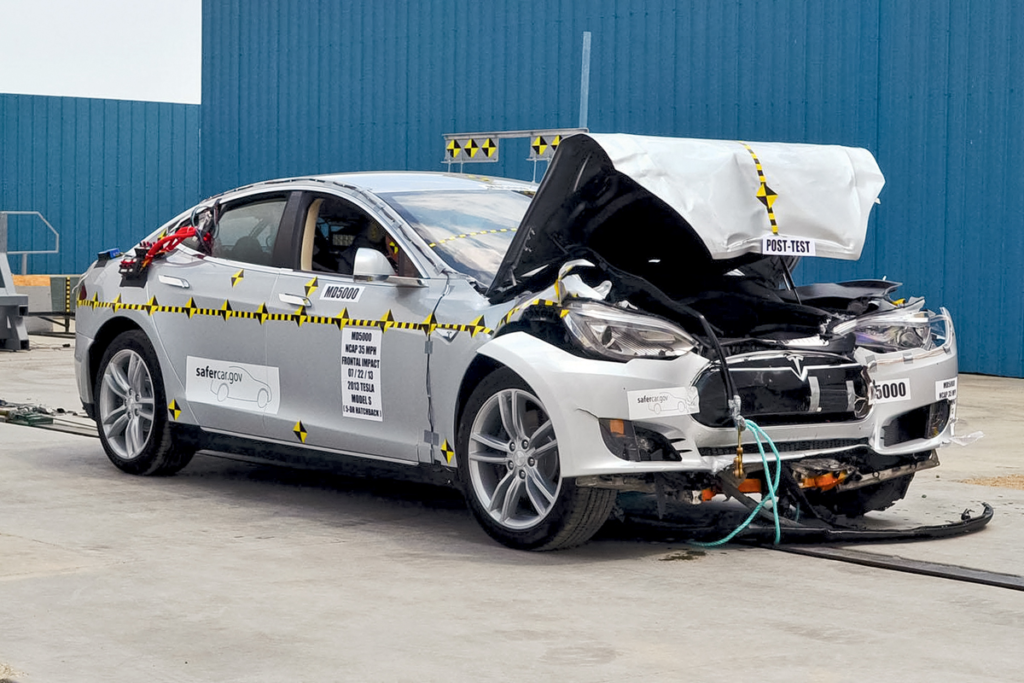
First public crash test in 2013 – NHTSA “Five-Star” 35 mph (56.3 km/h) frontal wall impact: no body deformation, only sensor readings are evaluated dummies.
Remarkably, the right seatbelt with the pyrotechnic device functioned efficiently. This is evidenced by the deformation of the passenger dummy’s calibrated ribs, which measured at 14 mm, significantly below the safe threshold of 22 mm. This is actually the lowest recording in the history of these crash tests! Additionally, the impact on the thighs, knees, and shins was within safe limits, indicating that injuries in these areas would most likely not necessitate medical intervention.

The bent steering wheel went under the dashboard visor. On the leather rim, there is a large scuff from the impact of the dummy’s forehead.
Now, focusing on the driver’s side, below the waist, the dummy fared excellently. The vehicle’s floor remained intact, the pedal displacement was minimal, and the knee airbag deployed effectively. However, the seatbelt on the driver’s side did not function at all, which is gravely concerning. As a result, the driver’s dummy experienced a forceful impact against the steering wheel with its forehead and chest, causing the rim to bend at the top. It is also pertinent to mention that the steering wheel was displaced by 50 mm (1.97 inches) to the side and almost 70 mm (2.76 inches) inwards.

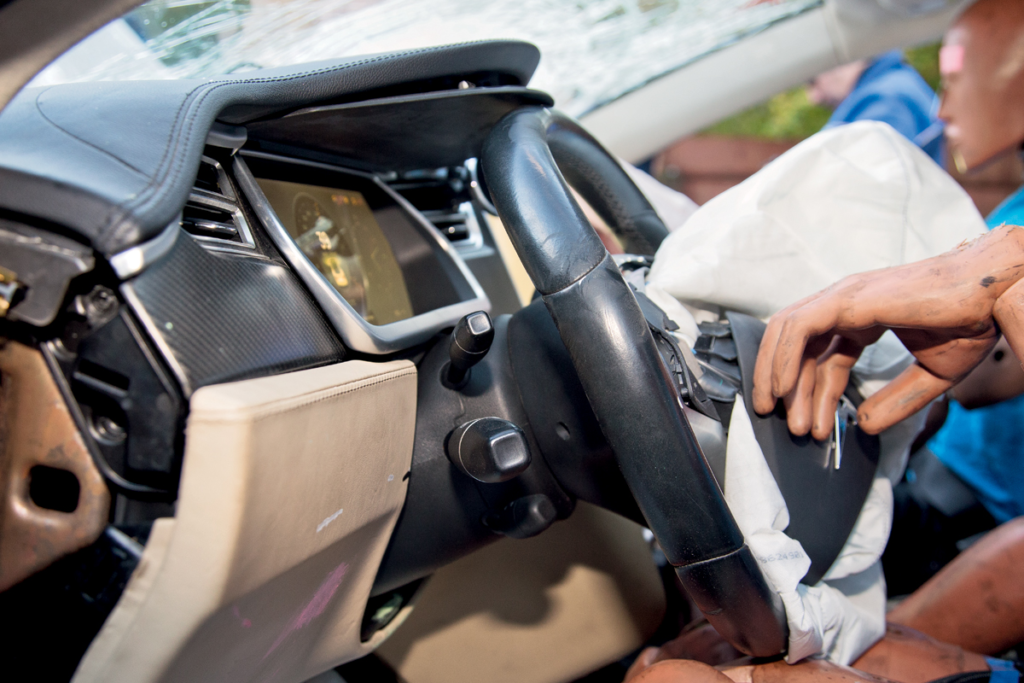
In this position, the shortened steering column was before the impact.
This led to a more severe impact on the driver’s ribs, with a deformation measuring at 26.9 mm. The peak deceleration experienced by the driver’s head was also considerably high at 84g. However, it is essential to consider that the average deceleration over three milliseconds was moderate at 65.2g. Furthermore, the integral criterion for the probability of head injury (HIC) was measured at 629, which is below the critical threshold of 1000. In comparison, the passenger’s HIC was even lower at 576.
One could ponder, what contributed to saving the driver from potentially more severe injuries, despite the seatbelt failure?

The driver’s legs are not threatened: the pedals barely shifted, the floor is in its original state.
To begin with, the vehicle’s structure performed commendably in the test. Despite shifting by 3-4 mm, the door opened without any significant effort, an important factor in ensuring occupant egress in the aftermath of a collision. It’s worth noting that a crease appeared on the windshield pillar, however, the deformation did not significantly reduce the opening, and the driver’s footwell was essentially untouched by any structural changes. Both the resilience of the cabin’s protective cage and the energy-absorbing capabilities of the longitudinal members (which, in this case, were previously repaired) deserve praise.

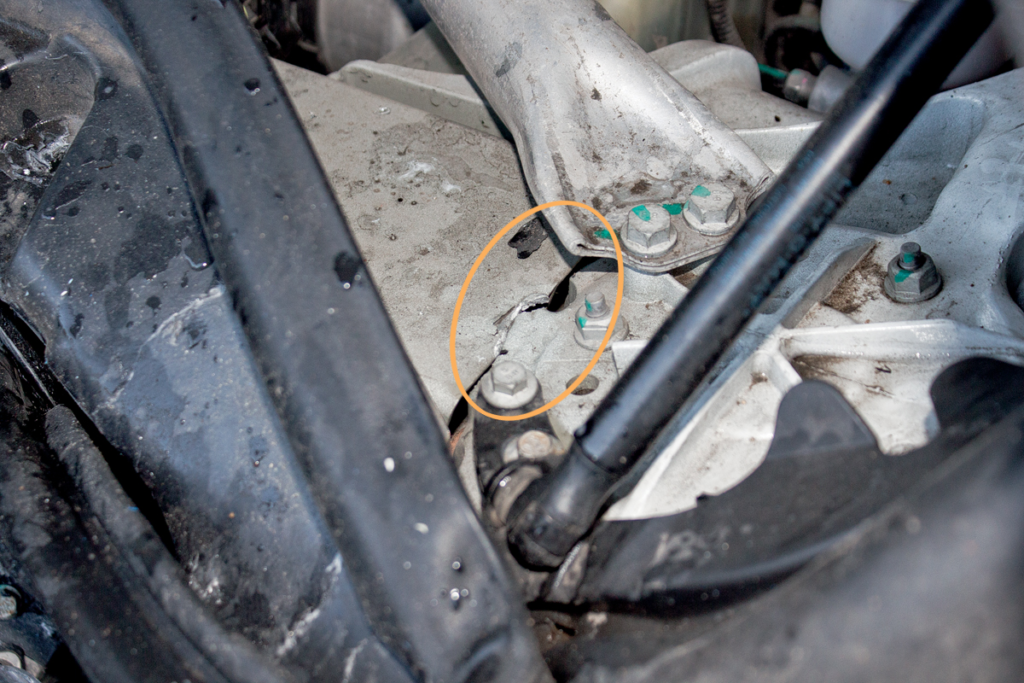
The cross member between the cups of the front suspension, which had survived during the previous accident, this time came off along welding.
Interestingly, the Tesla Model S features removable longitudinal members that are bolted to the body, facilitating potential repairs. Yet, it requires a careful process of gluing before securing them firmly. This complex procedure requires skilled craftsmanship and knowledge of different glues suitable for repairing aluminum bodies of Tesla cars. In areas prone to temperature deformation of the metal, a more flexible glue is used, whereas a denser red glue ensures a firm grip, as in the case of the longitudinal members. Additionally, the nuances of argon welding different aluminum alloys are significant: stronger materials are employed in the power structure, including subframes, while more ductile alloys are used for the body panels.

Marker inscriptions indicate that this airbag is from a salvage yard.
However, as observed, even after a non-official repair, the Tesla Model S managed to withstand a standard frontal collision with a 40% overlap remarkably well. The passive safety design of the interior played a pivotal role in this performance. As per American federal technical requirements FMVSS 208, vehicles are required to pass oblique frontal crash tests with unbuckled dummies at speeds up to 48 km/h (29.8 mph). The test results demonstrate how the flexible steering wheel, smooth front panel, and deployed airbags, including the knee airbag, managed to protect the driver from severe injuries, even in the absence of an effective seatbelt. These results highlight the importance of crash-worthy interior design in vehicle safety.

Judging by the deep scratches, the right headlight is original – it popped out during the first accident, but was put back in place.
Even after sustaining damage and undergoing non-standard repairs, the Tesla Model S still managed to achieve a commendable level of passive safety. Scoring 11.9 points out of a possible 16, and receiving three stars out of four, puts this car in the same league as vehicles like the Ford Focus I and Lada Vesta SW Cross in the ARCAP rating.

The score is approximate, as there is no score for neck protection. For head protection, we take the driver’s score of 2.9 points, for the chest – 3.3 points. Knees and thighs are green, while shins and feet get 3.7 points due to slightly increased loads on the driver again. Deducting one point for airbag penetration and for direct contact of the “driver’s” chest with the steering wheel, total score – 11.9
However, it’s vital to understand that the scores in points/stars should be perceived relatively and not absolutely. This is because the weight and size of the vehicle play a significant role in real-world crash scenarios. For instance, the Tesla Model S is considerably larger and almost twice as heavy as the Lada XRAY Cross or Volkswagen Polo sedan. This additional mass can have an impact on how the vehicle behaves in a collision.
Therefore, it wouldn’t be correct to directly equate the safety of the Tesla Model S with that of significantly smaller and lighter vehicles solely based on their crash test scores. It’s also worth noting that despite the test’s lack of strict scientific rigor, it is illustrative in highlighting the extent to which a high-end car like the Tesla Model S can experience a decrease in safety performance (17% loss in this case) due to past damages and non-official repairs.
Moreover, considering the resilience and repairability of the Tesla Model S body, it is plausible that the vehicle could be restored once again.
As for the iPhones, it seems that they did not fare well in the crash test. Neither of the two iPhone 14 models involved in the test functioned post-impact.
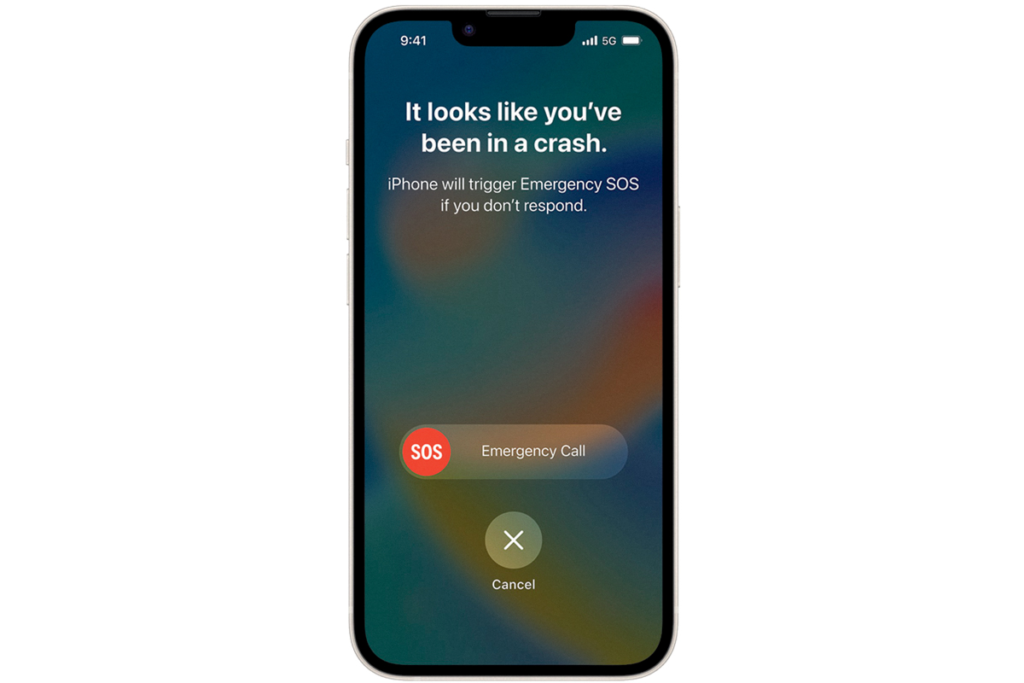
This is how the iPhone screen should look after an accident with the Crash Detection feature activated: if no one swipes the screen within ten seconds, an alarm will be triggered.
In theory, both iPhones should have displayed a message on their screens for ten seconds that says “It looks like you’ve been in a crash.” If you’re unable to respond, the device automatically calls emergency services.
The failure of the iPhones’ Crash Detection feature to activate in this scenario suggests that the feature might have some limitations or require further optimization. There might be certain boundary conditions or combinations of conditions that the system uses to determine whether a crash has occurred. For example, it might be looking for a sudden change in cabin pressure caused by airbag deployment. But in this crash test, all the windows were open, which might have influenced the internal pressure dynamics. Additionally, the feature might be calibrated to certain types of impacts or acceleration patterns that didn’t match this particular crash scenario.
It’s also noteworthy that false positives occurring during roller coaster rides. This illustrates the challenges in tuning such a system to be sensitive enough to detect real crashes without being so sensitive that it triggers in non-crash situations.
The Crash Detection feature, like many new technologies, may undergo iterations and improvements over time. As it becomes more refined, it’s likely to become more reliable in detecting crashes and providing timely assistance.
In conclusion, safety components like airbags and seat belts are vital in protecting the occupants of a vehicle during a crash, and it’s crucial to ensure that they are always in proper working condition.
You can watch the full video of our Crush Test on the Wylsacom chan.
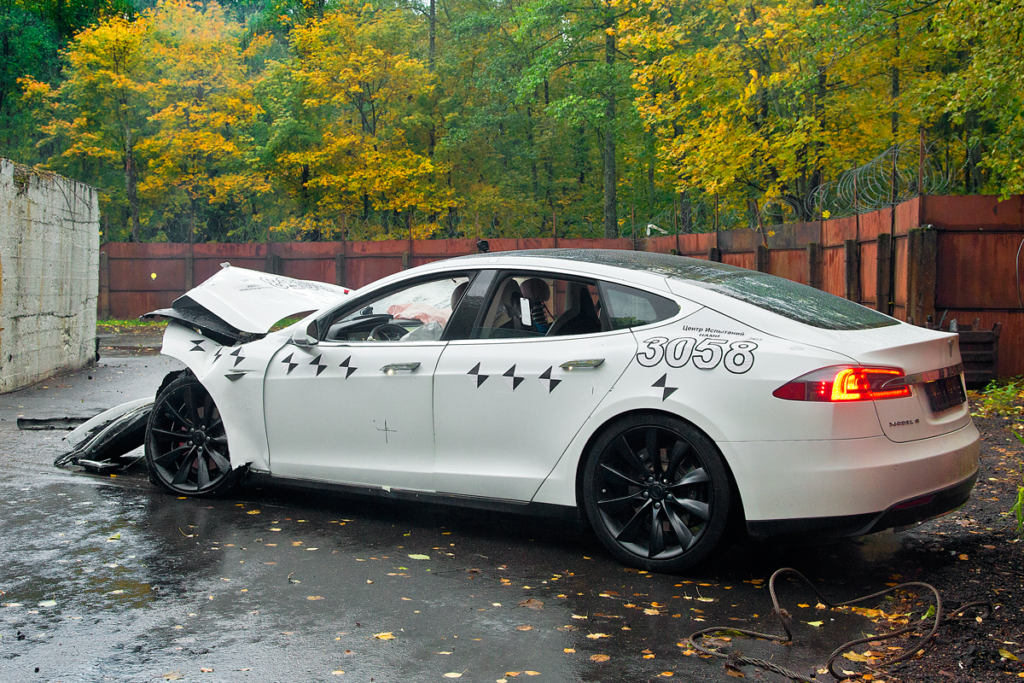
| Option | Tesla | Model S | ARCAP | regulations | |
| Dummy | Driver⠀ | Passenger | Driver | Passenger | |
| Max. head overload*, g | 65,17 | 76,45 | 72 | 88 | |
| HIC | 629 | 576 | 650 | 1000 | |
| Neck bending moment, Nm | N.d. | N.d. | 42 | 57 | |
| Chest compression, mm | 27 | 14 | 22 | 50 | |
| Maximum load on the femur, kN | 0.66 | 0.61 | 3.8 | 9.07 | |
| Worst TI tibia criterion | 0.47 | 0.31 | 0.4 | 1.3 | |
| Deformation of the left side of the body horizontally: | |||||
| Windshield pillar, mm Steering column end, mm Clutch/brake pedals, mm | 3 68 -/12 | 200 110 100 | 200 |
** N.d. – no data
Photo by IIHS | NHTSA | Dmitry Pitersky | Ilya Khlebushkin | Euro NCAP committee
This is a translation. You can read the original article here: Краш-тест восстановленной после аварии Tеслы Model S — есть запас прочности?

Published July 26, 2023 • 29m to read

